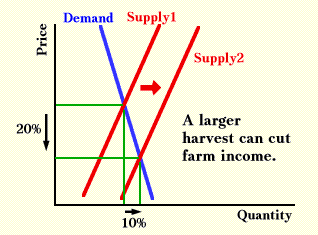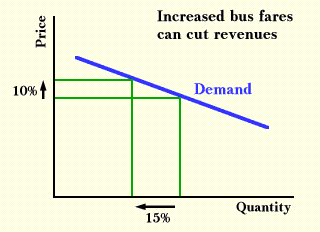More Price Elasticity
The concept of elasticity can help explain some situations that at first glance may seem puzzling. If American farmers all have excellent harvests, they may have a very poor year financially. They may be better off if they all have mediocre harvests. If a bus company decides it needs more revenue and tries to get it by raising fares, its revenues may decrease rather than increase.

In the case of the farmers, the key to their problem is that the demand curve for their products is quite inelastic. This means that if the harvest is unusually good, a large drop in price is necessary to encourage consumers to use the additional grain. If the elasticity coefficient is .5, for example, and the harvest is 10% larger than the previous year, then a 20% drop in prices will occur (assuming that the many things that we keep constant in drawing the demand curve have remained constant). Because this price reduction more than offsets the effect of the larger harvest, the average farmer's income drops.

For the bus company, the key is that demand is elastic. For example, suppose that the elasticity is 1.5. Then, if price is raised by 10%, quantity (ridership) must drop by 15%. But the drop in ridership more than offsets the increase in price, and so revenue will drop.
Just as we can measure how responsive buyers are to a change in price, we can measure how responsive sellers are. This measurement, the price elasticity of supply, has the same formula as price elasticity of demand, only the quantity in the formula will refer to the quantity that sellers will sell.
As with demand elasticity, supply elasticity depends on the amount of time available for adjustment. In the very short run, there may be no adjustments sellers can make, which would mean a perfectly vertical supply curve. For example, if on December 1 the price of apples doubles, there will be minimal effect on the number of apples available to the consumer. Producers cannot make adjustments until a new growing season begins. In the short run producers can use their facilities more or less intensively. In the apple example, they can vary the amounts of pesticides and the amount of labor they use to pick the apples. Finally, in the long run, not only can producers change their facilities, but they can also leave the industry or new producers may enter it. In our apple example, new orchards can be planted or old ones destroyed.
Now comes the technical stuff, a discussion on how to compute price elasticity.
>Copyright Robert Schenk